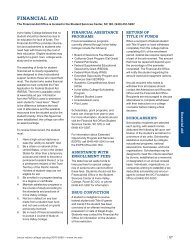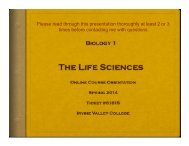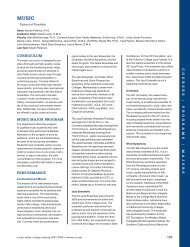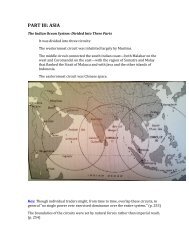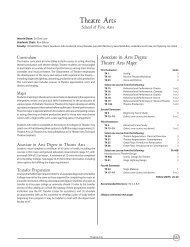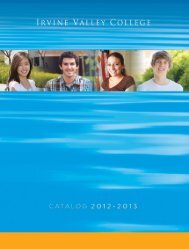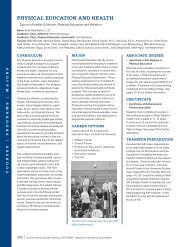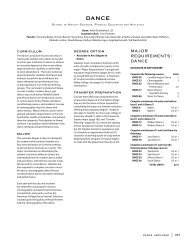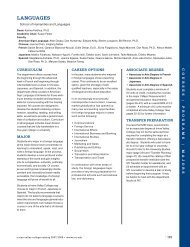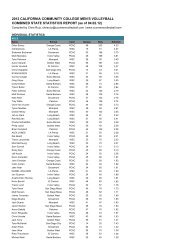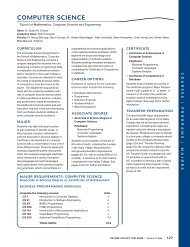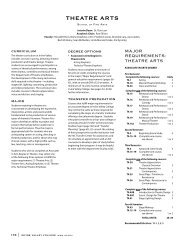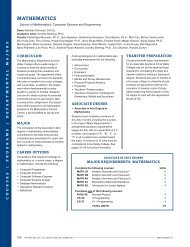Baroque Nationalism: Dutch Seascapes, Landscapes and Maps
Baroque Nationalism: Dutch Seascapes, Landscapes and Maps
Baroque Nationalism: Dutch Seascapes, Landscapes and Maps
You also want an ePaper? Increase the reach of your titles
YUMPU automatically turns print PDFs into web optimized ePapers that Google loves.
<strong>Baroque</strong> <strong>Nationalism</strong>:<br />
<strong>Dutch</strong> <strong>Seascapes</strong>,<br />
<strong>L<strong>and</strong>scapes</strong>, <strong>and</strong> <strong>Maps</strong><br />
Tiana Barnard, Margo Campbell<br />
Joshua Lee, <strong>and</strong> Iyesha van den Haak<br />
Irvine Valley College<br />
Art History Survey II: Western
History<br />
• The <strong>Baroque</strong> era was a period of great change. During this time, the<br />
European regions went through religious dispersion. The Christian<br />
religion separated into two different groups, the Catholics <strong>and</strong> the<br />
Protestants. The conflicts extended to the battlefield <strong>and</strong> the arts.<br />
The Catholics <strong>and</strong> Protestants tried to convert people using art as a<br />
media tool.<br />
• The seventeenth century is referred to as the Golden Age of the<br />
<strong>Dutch</strong>, because it is a time of religious tolerance <strong>and</strong> economic<br />
success. The <strong>Dutch</strong> people of the seventeenth century belonged to a<br />
republic governed by its citizens at a time when its neighbors;<br />
Germany, France, <strong>and</strong> Engl<strong>and</strong> were still ruled by monarchs.<br />
Although the long battle for freedom from Spain was won in 1609, it<br />
was not officially recognized by Spain until 1648. The <strong>Dutch</strong> Republic<br />
had to be continually defended <strong>and</strong> the maritime fleet grew to be the<br />
leading sea power of the seventeenth century.
Along with this new political independence came economic<br />
independence. Amsterdam had become a major port in the<br />
world. The existence of the new <strong>Dutch</strong> Republic as an<br />
independent power relied on both the military <strong>and</strong> merchant<br />
shipping. Trading <strong>and</strong> shipping were the main generators of<br />
wealth <strong>and</strong> the emergence of the Vereenigde Oostindische<br />
Compagnie (VOC/<strong>Dutch</strong> East Indies Trading Company) helped<br />
to establish Amsterdam as the port at the center of world trade.<br />
It eventually shifted to Rotterdam <strong>and</strong> Rotterdam continues to<br />
this day to be the largest <strong>and</strong> busiest port in the world.
Cultural Influences<br />
• Since the <strong>Dutch</strong> were an independent republic <strong>and</strong> a primarily<br />
Protestant country, they lost two major art patrons: the church<br />
<strong>and</strong> the royal family. A shift occurred <strong>and</strong> middle <strong>and</strong> upper<br />
class society became the new art patrons. The <strong>Dutch</strong> had a<br />
streak of success. They had mercenaries for protection <strong>and</strong> a<br />
vast wealth through commerce <strong>and</strong> trade. Due to the need for<br />
arable farml<strong>and</strong>, the <strong>Dutch</strong> overcame the restrictions of being<br />
below sea level which resulted in submerged terrain <strong>and</strong><br />
massive swampl<strong>and</strong>s. Through the use of canals, dikes, <strong>and</strong><br />
mills they lowered the water levels <strong>and</strong> gained the possibility of<br />
increased farml<strong>and</strong>.<br />
• As a result of increased trade <strong>and</strong> commerce, the <strong>Dutch</strong><br />
became the major seafaring merchants of the Golden Age. This<br />
further encouraged pride <strong>and</strong> passion among the citizens for<br />
their l<strong>and</strong>, <strong>and</strong> created <strong>Dutch</strong> <strong>Nationalism</strong>. This was the first<br />
existing nationalistic community in the <strong>Baroque</strong> period. The<br />
l<strong>and</strong>scape paintings complemented their technological<br />
accomplishments, whereas the seascape paintings glorified<br />
their military victories <strong>and</strong> trade.
The <strong>Dutch</strong> nation was going through a time of strong <strong>and</strong> adamant<br />
national identity, <strong>and</strong> cartographers of the time, were reflecting this in the<br />
design of Leo Belgicus <strong>Maps</strong>. These were maps fashioned in the shape of a<br />
lion. The lion was already a national icon used on the coat of arms <strong>and</strong><br />
military armor to symbolize their national pride <strong>and</strong> power. While Nicolas<br />
Visscher was the first cartographer to publish such a map, it became<br />
extremely popular throughout the cartographic community. There are<br />
three variations in which the lion inspired maps are depicted; in the first<br />
the lion is facing right with its right paw raised, second the lion is sitting<br />
facing left, <strong>and</strong> the third variation is called the Leo Holl<strong>and</strong>icus, which only<br />
shows the layout of Holl<strong>and</strong>.
Subject<br />
&<br />
Style<br />
• It is clear when browsing a selection of <strong>Dutch</strong> 17 th century paintings,<br />
that there are favorable subjects. One of the most important<br />
subjects of this time is l<strong>and</strong>scape. The surge of l<strong>and</strong>scape popularity<br />
was a direct result of the newfound independence of the <strong>Dutch</strong><br />
Republic. The <strong>Dutch</strong> were interested in paintings of l<strong>and</strong>scapes<br />
occurring in their geographic area because they were proud of their<br />
urbanization. <strong>L<strong>and</strong>scapes</strong> done during this time are often depicted<br />
with excruciating detail. The <strong>Dutch</strong> were concerned with visually<br />
describing everything in their paintings. In painting l<strong>and</strong>scapes,<br />
they sought to accurately depict every detail of the terrain. The<br />
<strong>Dutch</strong> invented the panoramic view, which extended the traditional<br />
l<strong>and</strong>scape view, <strong>and</strong> allowed painters to create a wider <strong>and</strong> more<br />
unhindered composition.
• <strong>Dutch</strong> seascape painting was usually focused on oversea<br />
battles with Spain <strong>and</strong> had a tendency to depict a lot of drama.<br />
The artists’ goals were to portray the <strong>Dutch</strong> heroically by<br />
displaying their struggle <strong>and</strong> fight for freedom.<br />
• <strong>Maps</strong> of their homel<strong>and</strong> were very popular to the <strong>Dutch</strong>, but<br />
there were many other countries that the <strong>Dutch</strong> cartographers<br />
mapped. Hessel Gerritsz documented the geography of<br />
Australia <strong>and</strong> the Indonesian Isl<strong>and</strong>s. Not only were the maps<br />
some of the best printed by printing houses in Amsterdam,<br />
they were also included in works of art, serving as<br />
backgrounds.
Materials & Processes<br />
• The materials used by the painters in the <strong>Dutch</strong> <strong>Baroque</strong><br />
period were most likely unified. They used oil paint possibly<br />
with hog hair brushes. Artists employed the use of a wooden<br />
palette as a surface for mixing paint. The canvases had to be<br />
manually stretched, attached to a wooden frame, <strong>and</strong> then<br />
placed on an easel.<br />
• Painting processes varied. Artists often used a cartoon to<br />
help visualize their final product.
• There are multiples ways a cartographer<br />
can construct a map. The most common one used by the <strong>Dutch</strong><br />
was called Copperplate Engraving. The necessary tools are: a burin<br />
which is a metal tool with a sharp point to engrave, a copper plate<br />
that is an engraved template of the map, ink, a roller, paper, <strong>and</strong> a<br />
rolling press which compresses the copper plate with ink to ensure<br />
that the ink transfers onto the paper. The process includes<br />
engraving the plate with the burin <strong>and</strong> then applying ink into the<br />
grooves. The plate is then laid onto the paper <strong>and</strong> passed through<br />
a rolling press to completely transfer the ink to the paper.
Artistic Examples<br />
View of Haarlem with Bleaching Grounds<br />
Jacob Van Ruisdael,<br />
1660<br />
By Tiana Barnard<br />
Battle of Gibraltar /De Zeeslag bij Gibraltar<br />
Cornelis Claesz van Wieringen<br />
1621<br />
By Iyesha van den Haak<br />
The Maas at Dordrecht<br />
Aelbert Cuyp<br />
1650<br />
By Joshua Lee<br />
Leo Holl<strong>and</strong>icus<br />
Nicolas Visscher<br />
1648<br />
By Margo Campbell
View of Haarlem<br />
with Bleaching<br />
Grounds<br />
Jacob Van Ruisdael
View of Haarlem with Bleaching Grounds<br />
Tiana Barnard<br />
View of Haarlem with Bleaching Grounds painted by Jacob Van<br />
Ruisdael in 1660, is a wonderful example of the style of l<strong>and</strong>scape<br />
painting that was emerging in the <strong>Dutch</strong> 17th century. This style<br />
evolved out of the <strong>Dutch</strong> independence, which inspired a new kind of<br />
<strong>Nationalism</strong> that left the <strong>Dutch</strong> full of pride <strong>and</strong> respect for their<br />
accomplishments.<br />
As one of the most important artists of his time, Ruisdael beautifully<br />
depicts the glory <strong>and</strong> pride of the Golden Age of the <strong>Dutch</strong> Republic.<br />
The sky in View of Haarlem with Bleaching Grounds takes up the<br />
majority of the canvas, which was a popular technique employed at<br />
the time. Ruisdael not only paints a view of Haarlem, which was an<br />
important city in the <strong>Dutch</strong> Republic, but he also includes the<br />
bleaching grounds which were a vital part of the country’s successful<br />
linen industry. Including the bleaching grounds speaks to the<br />
economic success of the <strong>Dutch</strong>, while the great expanse of the<br />
l<strong>and</strong>scape speaks to their agricultural developments, <strong>and</strong> the<br />
buildings in the distance allude to the pride they felt as a result of<br />
their urbanization.
Ruisdael is visually describing every aspect of the l<strong>and</strong>scape in<br />
an exquisite manner. The artist painted people working in the<br />
bleaching fields, but they are small in comparison to the<br />
l<strong>and</strong>scape surrounding them, which tells the viewer that this<br />
work is not just about the figures. Ruisdael did not paint a<br />
specific subject occupying the center of the canvas, so when the<br />
viewer looks at the work it is not clear where their eyes should<br />
be focused. Although there is a church in the painting, it is not<br />
the focal point of the picture, it’s merely addressed as part of the<br />
l<strong>and</strong>scape.<br />
The purpose of this painting is to offer a representation of the<br />
<strong>Dutch</strong> environment of the time, not focus on a single subject.<br />
Ruisdael painted <strong>Dutch</strong> <strong>Baroque</strong> l<strong>and</strong>scapes with a sincerity<br />
<strong>and</strong> delicateness that was unique among his peers. As a result<br />
of his ingenuity, his paintings will forever be a reminder of the<br />
allegiance <strong>and</strong> spirit of the Golden Age of the <strong>Dutch</strong>.
Battle of Gibraltar /De Zeeslag bij Gibraltar<br />
Cornelis Claesz van Wieringen c. 1621<br />
Oil on canvas 137.5 x 188 cm
Battle of Gibraltar<br />
Iyesha van den Haak<br />
On 25 April 1607, thirty <strong>Dutch</strong> ships under the leadership of Admiral<br />
Jacob van Heemskerck surprised the anchored Spanish fleet <strong>and</strong><br />
within four hours the entire Spanish fleet was destroyed. The Spanish<br />
had been threatening the <strong>Dutch</strong> trade routes <strong>and</strong> this proved to be the<br />
first great victory of the Eighty Years War (1568-1648) for the <strong>Dutch</strong>.<br />
Four thous<strong>and</strong> Spaniards <strong>and</strong> a hundred <strong>Dutch</strong>men were killed along<br />
with the <strong>Dutch</strong> <strong>and</strong> Spanish Admirals.<br />
The painting depicts the triumph of the victory with the explosion of<br />
the Spanish flagship. Spaniards are being blown from their ship, body<br />
parts are flying in the air, <strong>and</strong> the sea is turning red from the blood.<br />
The enemy is Catholic which is evident from the falling angel <strong>and</strong><br />
Virgin Mary that are protective ornaments on the ship.<br />
The <strong>Dutch</strong> <strong>and</strong> Spanish ships are shown converging at the center of<br />
the image where the Spanish flagship is portrayed in quick <strong>and</strong><br />
immediate brush strokes. The color palette is cool blues <strong>and</strong> grays for<br />
the sky <strong>and</strong> sea. There are intense reds, oranges, <strong>and</strong> yellows<br />
indicating the heat of the flames on the ship <strong>and</strong> deep crimson for the<br />
blood mixing with the water.
Cornelis Claesz van Wieringen paid very careful attention to detail such<br />
as the uniforms <strong>and</strong> weapons used. He understood the subject matter.<br />
He had been a sailor before he became a painter. His use of a high<br />
perspective <strong>and</strong> wide angle allowed for more detail in the scene.<br />
<strong>Dutch</strong> seascape painting was mainly maritime accounts of famous<br />
battles or displays of the powerful <strong>and</strong> glorious fleets. The emergence<br />
in the 17th century of seascape painting functioned as important<br />
public monuments that were often commissioned by town councils or<br />
admiralty colleges. The predominately Protestant <strong>Dutch</strong> population<br />
preferred paintings that expressed pride in their country <strong>and</strong> images<br />
that depicted their independence from Spain.<br />
Hendrik Cornelisz Vroom is considered to be the father of <strong>Dutch</strong><br />
Maritime painting. He belonged to the Guild of St. Luke of Haarlem<br />
<strong>and</strong> was able to develop his style with out being dictated to by the<br />
church or aristocracy. Cornelis Claesz van Wieringen, also a citizen of<br />
Haarlem, was a student of Vroom.<br />
Rembr<strong>and</strong>t van Rijn, the great <strong>Dutch</strong> Master of portraits also<br />
contributed to <strong>Dutch</strong> seascape painting. Although he painted only one<br />
known seascape, The Storm on the Sea of Galilee it has become part of<br />
one of the biggest museum heists in history. It was in the collection of<br />
The Gardner Museum in Boston until it was stolen in 1990. It has not<br />
yet been recovered.
The Maas at Dordrecht,<br />
Aelbert Cuyp, 1650
The Maas at Dordrecht<br />
Joshua Lee<br />
The name of the painting is The Maas at Dordrecht. It was painted in the year 1650.<br />
The painter of this artwork goes by the name Aelbert Cuyp. He was born on the<br />
20 th of October in 1620. He is a leader in <strong>Dutch</strong> l<strong>and</strong>scape painting. He is most<br />
known for his countryside l<strong>and</strong>scapes in Dordrecht. After he became married, his<br />
production of art dramatically decreased. This was probably due to his increased<br />
involvement in the church community. He died on November 15, 1691.<br />
This painting strays away from Cuyp’s normality by being a seascape. But he still<br />
incorporates his signature sunrise scene. This picture is during a festival. The<br />
festival is to honor 30,000 soldiers. These soldiers contributed to The Thirty<br />
Years’ War. This scene is show the fleets of ships taking the soldiers home as the<br />
war draws near to an end. The man st<strong>and</strong>ing in the dinghy has more attention to<br />
him than anyone else. He could possibly be the patron of this painting.<br />
The painting is obviously a seascape. It was painted using oil paint. It is painted on<br />
a canvas. The canvas was manually stretched. The painting is 45 ¼ x 67 inches.<br />
The brush strokes soften as the picture distances. The painting becomes bore<br />
clear <strong>and</strong> textured as it comes near. The composition is asymmetrical. There is<br />
no center concentration. The painting is dominantly warm. The use of color<br />
creates the depth of the painting; the further objects are, the more the objects<br />
become the color of the sky.<br />
The painting is a wonderful composition. The details <strong>and</strong> meticulous nature is<br />
remarkable. There is no question why Cuyp was a leading <strong>Dutch</strong> l<strong>and</strong>scape<br />
painter. This painting is a great example of a <strong>Dutch</strong> seascape.
Leo Holl<strong>and</strong>icus, Nicolas Visscher, 1648
Leo Holl<strong>and</strong>icus<br />
Margo Campbell<br />
This is a map done by cartographer Nicolas Visscher in 1648.<br />
The cartography method used was copperplate engraving. This<br />
map includes the seven united provinces located only in the<br />
area of Holl<strong>and</strong> expressed in the shape of the lion. The idea was<br />
created because the provinces form a similar shape to that of a<br />
lion. Also, the lion was a national icon, placed on many coats-ofarms<br />
throughout the province colonies. The lion brought a<br />
sense of pride to the nation. At the time they were experiencing<br />
power struggles from Spain <strong>and</strong> this was another symbol of<br />
their unity.<br />
In this particular map the lion is also holding a sword that<br />
reads Patriae Defensio, which translates to Country Defense.<br />
This further advocates the national pride of the country <strong>and</strong><br />
their dedication to whom they are as a people.
Printed Sources<br />
• Borngåsser, B. <strong>Baroque</strong> <strong>and</strong> Rococo. Berlin, Germany: Feierbend Verlag,<br />
2003.<br />
• Fuchs, R.h. <strong>Dutch</strong> Painting. London, Engl<strong>and</strong>: Oxford University Press, 1978.<br />
• Mamiya, Christin <strong>and</strong> Fred Kleiner. Gardner’s Art Through the Ages. 12 th ed.<br />
Vol. 2. United States: Thomson Wadsworth, 2006.<br />
• Minor, Vernon. <strong>Baroque</strong> & Rococo Art & Culture. New York: Abrams, 1999<br />
• Slive, Seymour. Jacob Van Ruisdael a Complete Catalogue of His Paintings,<br />
Drawings <strong>and</strong> Etchings. Connecticut: Yale University Press, 2002.<br />
• Wheelock, Arthur. <strong>Dutch</strong> Paintings of the Seventeenth Century. New York:<br />
Oxford University Press, 1995<br />
• van Guldener, H . Rijksmuseum Amsterdam Paintings.Germany: Knorr &<br />
Hirth Verlag, 1976<br />
• A Moral Compass; Seventeenth <strong>and</strong> Eighteenth Century Painting in the<br />
Netherl<strong>and</strong>s. Lawrence O. Goedde. Gr<strong>and</strong> Rapids Art Museum.Cambridge,<br />
U.K.: W.B. Eerdmans Publishing, 1999.<br />
• Rijksmuseum Amsterdam; The Masterpieces Guide, M. Dominicus-van Soest.<br />
Amsterdam, The Netherl<strong>and</strong>s: Kunstdrukkerij Mercurius-Wormerveer, 2003.<br />
• The Frans Hals Museum Haarlem, A. Erftemeijer, H. Snethlage, N. Køhler.<br />
Amsterdam, The Netherl<strong>and</strong>s: Ludion, 2004.
Internet Sources<br />
• The Art of Cartography,<br />
http://gallery.sjsu.edu/cartography/maps/index.html<br />
• Altea <strong>Maps</strong> & Books<br />
http://www.mapforum.com/12/12curio.htm<br />
• Terra Incognita, http://www.terra-maps.com/index.html<br />
• www.nmm.ac.uk<br />
• www.encyclopedia.farlex<br />
• www.boston.com.news<br />
• Rijksmuseum.nl<br />
• www.minbuza.nl/history/en<br />
• en.wikipedia.org/wiki/Aelbert_Cuyp<br />
• www.nga.gov/collection/gallery/gg47/gg47-579.0.html



